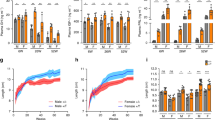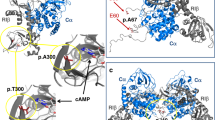Abstract
THE pituitary hormone thyrotropin stimulates the function, expression of differentiation and growth of thyrocytes by cyclic AMP-dependent mechanisms1–3. Tissue hyperplasia and hyperthyroidism are therefore expected to result when activation of the adenylyl cyclase–cAMP cascade is unregulated. This is observed in several situations4,5, including when somatic mutations impair the GTPase activity of the G protein Gsα (refs 6, 7). Such a mechanism is probably responsible for the development of a minority of monoclonal hyperfunctioning thyroid adenomas6,8,9. Here we identify somatic mutations in the carboxv-terminal portion of the third cytoplasmic loop of the thyrotropin receptor in three out of eleven hyperfunctioning thyroid adenomas. These mutations are restricted to tumour tissue and involve two different residues (aspartic acid at position 619 to glycine in two cases, and alanine at position 623 to isoleucine in one case). The mutant receptors confer constitutive activation of adenylyl cyclase when tested by transfection in COS cells. This shows that G-protein-coupled receptors are susceptible to constitutive activation by spontaneous somatic mutations10,11 and may thus behave as proto-oncogenes.
This is a preview of subscription content, access via your institution
Access options
Subscribe to this journal
Receive 51 print issues and online access
$199.00 per year
only $3.90 per issue
Buy this article
- Purchase on Springer Link
- Instant access to full article PDF
Prices may be subject to local taxes which are calculated during checkout
Similar content being viewed by others
References
Dumont, J. E., Vassart, G. & Refetoff, S. in The Metabolic Basis of Inherited Diseases (ed. Scriver C.R.) 1843–1879 (McGraw-Hill, USA, 1989).
Dumont, J. E., Lamy, F., Roger, P. & Maenhaut, C. Physiol. Rev. 72, 667–697 (1992).
Dumont, J. E., Jauniaux, J. C. & Roger, P. P. Trends biochem. Sci. 14, 67–71 (1989).
Weintraub, B. D., Gershengorn, M. C., Kourides, I. A. & Fein, H. Ann. intern. Med. 95, 339–351 (1981).
Zakarija, M. & McKenzie, J. M. Exp. clin. Endocr. 97, 165–169 (1991).
Lyons, J. et al. Science 249, 655–659 (1990).
Weinstein, L. S. et al. New Engl. J. Med. 325, 1688–1695 (1991).
O'Sullivan, C., Barton, C. M., Staddon, S. L., Brown, C. L. & Lemoine, N. R. Molec. Carcinog. 4, 345–349 (1991).
Suarez, H. G. et al. Oncogene 6, 677–679 (1991).
Kjelsberg, M. A., Cotecchia, S., Ostrowski, J., Caron, M. G. & Lefkowitz, R. J. J. biol. Chem. 267, 1430–1433 (1992).
Allen, L. F., Lefkowitz, R. J., Caron, M. G. & Cotecchia, S. Proc. natn. Acad. Sci. U.S.A. 88, 11354–11358 (1991).
Landis, C. A. et al. Nature 340, 692–696 (1989).
Van Sande, J. et al. J. clin. Endocr. Metab. 50, 776–785 (1980).
Van Sande, J. et al. J. clin. Endocr. Metab. 66, 570–579 (1988).
Thomas, G. A., Williams, D. & Williams, E. D. Am. J. Path. 134, 141–151 (1989).
Kosugi, S. J. biol. Chem. 267, 24153–24156 (1992).
Strosberg, A. D. Eur. J. Biochem. 196, 1–10 (1991).
O'Dowd, B. F. et al. J. biol. Chem. 263, 15985–15992 (1988).
Ruvkun, G. Nature 360, 711–712 (1992).
Robbins, L. S. et al. Cell 72, 827–834 (1993).
Libert, F. et al. Biochem. biophys. Res. Commun. 165, 1250–1255 (1989).
Christophe, D. et al. Molec. cell Endocr. 64, 5–18 (1989).
Brooker, G., Harper, J. F., Terasaki, W. L. & Moylan, R. D. Adv. Cyclic Nucleotide Res. 10, 1–33 (1979).
Berridge, M. J. Biochem. J. 212, 849–858 (1983).
Sambrook, J., Fritsch, E. F. & Maniatis, T. Molecular Cloning: A Laboratory Manual (Cold Spring Harbor Laboratory Press, New York, 1989).
Vassart, G. et al. Science 235, 683–684 (1987).
Author information
Authors and Affiliations
Rights and permissions
About this article
Cite this article
Parma, J., Duprez, L., Sande, J. et al. Somatic mutations in the thyrotropin receptor gene cause hyperfunctioning thyroid adenomas. Nature 365, 649–651 (1993). https://doi.org/10.1038/365649a0
Received:
Accepted:
Published:
Issue Date:
DOI: https://doi.org/10.1038/365649a0
This article is cited by
-
Genomic alterations in thyroid cancer: biological and clinical insights
Nature Reviews Endocrinology (2024)
-
Single-molecule visualization of human A2A adenosine receptor activation by a G protein and constitutively activating mutations
Communications Biology (2023)
-
Pathogenesis of cancers derived from thyroid follicular cells
Nature Reviews Cancer (2023)
-
Molecular pathology of endocrine gland tumors: genetic alterations and clinicopathologic relevance
Virchows Archiv (2023)
-
Overview of the 2022 WHO Classification of Thyroid Neoplasms
Endocrine Pathology (2022)
Comments
By submitting a comment you agree to abide by our Terms and Community Guidelines. If you find something abusive or that does not comply with our terms or guidelines please flag it as inappropriate.



